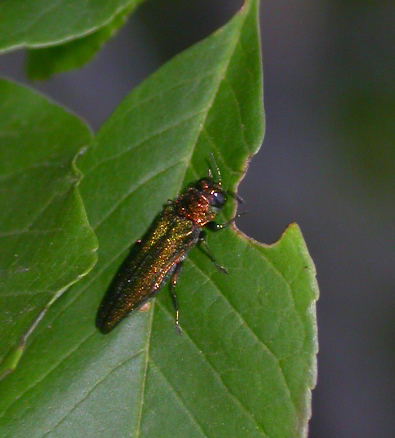Emerald Ash Borer found in another part of infested county is no surprise, according to Jodie Ellis
Herald Journal
Kevin Howell
August 14, 2008
 |
| Emerald Ash Borer feeding on leaf |
Emerald ash borer, an invasive little green beetle that has been causing devastating damage to North American ash trees after arriving in the United States from Asia in the early 1990s, has spread to yet another area in Indiana.
Already found in 19 Hoosier counties including White County, it was discovered recently in another township of already infested Wells County.
Last week according to information from Purdue University, an alert citizen in Harrison Township which encompasses the southern half of the town of Bluffton noticed an ash borer hanging on to the windshield of his vehicle and turned the insect over to the Wells County Purdue Extension office.
Purdue exotic insect education coordinator Jodie Ellis said the discovery of the insect was not surprising. "The find in Harrison Township is not unexpected but should serve as a reminder that an informed, concerned citizen is a powerful weapon against this insect," said Ellis. "The earlier we detect EAB, the more we can do to keep it from spreading."
Wells and White counties are two of 19 counties under quarantine orders for emerald ash borer including Adams, Allen, DeKalb, Elkhart, Floyd, Hamilton, Huntington, Kosciusko, LaGrange, Marion, Noble, Porter, Randolph, St. Joseph, Steuben, Wabash and Whitley.
The emerald ash borer, first found in Indiana in 2004, is a bright green insect that is visible only during the summer. Infested trees have D-shaped exit holes in the main trunk of the tree. Other signs include vertical splits in the bark and increased woodpecker activity.
While citizen vigilance and curtailing the movement of firewood and lumber that may harbor the insect are two strategies to contain the infestation that has already destroyed 25 million ash trees in the U.S., ongoing research into ways to combat the insect is showing some promise.
In White County, Purdue entomologists and other researchers have been testing a variety of insecticides on infested trees at Indiana Beach Campground.
Entomology professor Cliff Sadof said he and others are testing at least three different insecticides. "We are working with TreeAge, Imidacloprid and Safari at Indiana Beach. It is too soon to tell which products are working better," said Sadof. "The good news is that many of the treated trees have started to heal. The only reason the tree can do this is that the annual applications of insecticides are killing enough beetles to make the tree strong enough to maintain its normal healing response. "From the tree's perspective healing the hole is no different than sealing up a wound after a limb has been removed."
Sadof explained that a vertical split in some trees caused by the insect infestation slowly grows over with a fine brown ridge of callus tissue covering the split and leaving a scar.
The research at Indiana Beach has been going for about a year to allow for the annual applications and see if that approach can save infested trees.
White County Extension educator Greg Bossaer said the proximity of White County to Purdue has offered an opportunity to test different methods.
"From a positive standpoint the White County EAB infestation is very close to Purdue and allowed researchers like Dr. Sadof an opportunity to treat the infested trees with different products," Bossaer explained. "As of now that localized infestation does not appear to have spread very far from the original infestation site, plus researchers were able to evaluate multiple products."
Unfortunately Bossaer said the infestation is likely to continue to be a threat.
"EAB will continue to be a threat throughout the county even though we haven't had any new confirmed EAB infestation sites. DNR (Department of Natural Resources) entomologists are regularly investigating possible new infestation sites in the county," said Bossaer. "I would not be surprised if a new infestation was confirmed in the future." |